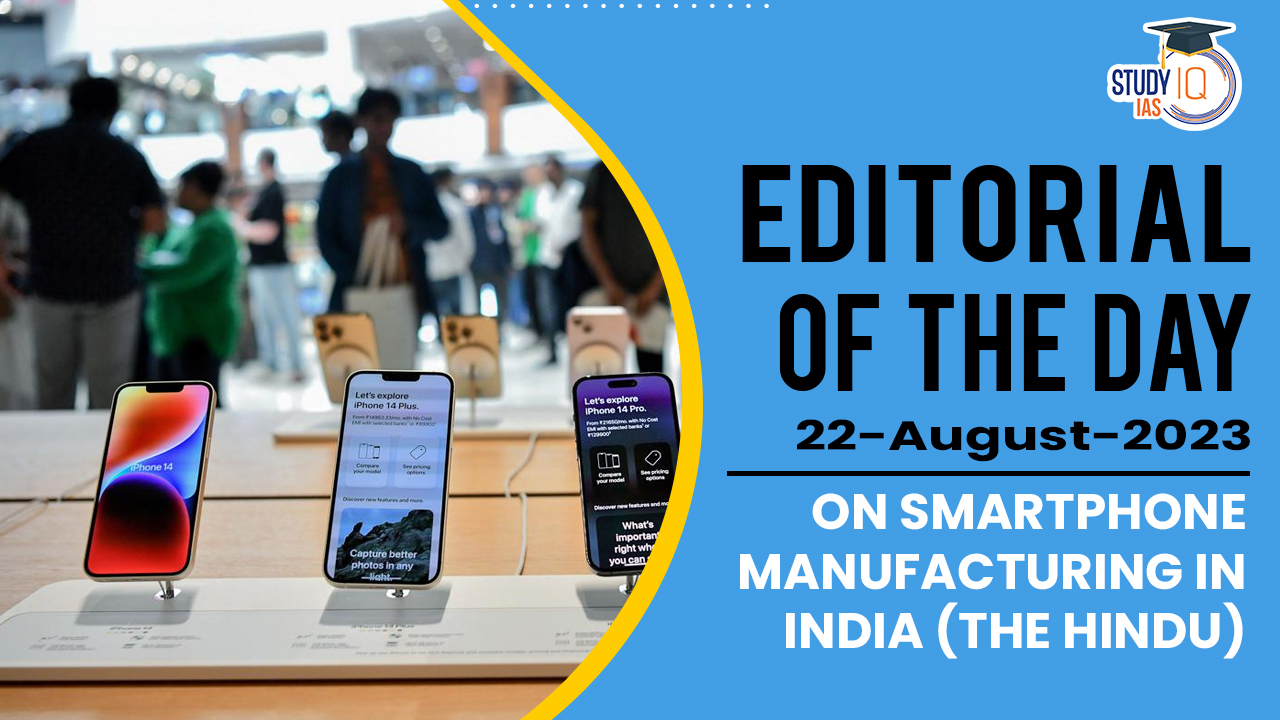Context: The article is discussing a debate between former Reserve Bank of India (RBI) governor Raghuram Rajan and the Minister of State for Electronics Rajeev Chandrasekhar regarding the effectiveness of a Central government scheme (production-linked incentives (PLI) scheme) in India aimed at boosting electronics manufacturing. The focus of this scheme has particularly been on the electronics manufacturing sector. The article points out that the smartphone manufacturing industry has shown a significant interest in the PLI scheme. As a result of the scheme, the exports of mobile phones have surged from $300 million in the fiscal year (FY) 2018 to a remarkable $11 billion in FY23. Overall, the article delves into the discussion and disagreement between experts about whether the PLI scheme has been successful in achieving its intended goals of boosting electronics manufacturing and reducing import dependence in India’s smartphone industry.
Decoding the Editorial
About the PLI Scheme:
- Around five years ago, the Indian government implemented the PLI scheme with the goal of encouraging more companies, whether domestic or foreign, to manufacture products within India.
- Under this scheme, companies receive financial incentives from the government for manufacturing goods within the country.
- The focus of this scheme has particularly been on the electronics manufacturing sector.
Debate between Experts:
- However, a disagreement has emerged between Raghuram Rajan and the Minister of State for Electronics Rajeev Chandrasekhar regarding the impact of the PLI scheme.
- The former argues that while the imports of fully assembled mobile phones have decreased, the imports of mobile phone components have risen notably between FY21 and FY23.
-
- This raises a concern about the extent to which the PLI scheme has truly led to the development of a self-sufficient electronics manufacturing ecosystem in India, as the increase in component imports might indicate a reliance on foreign-made components even as final assembly takes place domestically.
Arguments by Raghuram Rajan
- Dependency on Imports: Rajan contends that while the PLI scheme has led to an increase in mobile phone exports, the focus has primarily been on low-level assembly work.
-
- This means that while the final products might be labelled as “Made in India,” a significant portion of the components used in these products is still imported.
- He specifically points out that imports of mobile phone components such as display screens, batteries, cameras, and printed circuit boards have risen substantially.
- Limited Value Addition: Rajan highlights that the current approach lacks substantial value addition within India’s borders.
-
- The assembly-based model does not involve a comprehensive supply chain that includes the production of essential components domestically.
- This type of assembly work doesn’t generate high-paying jobs and lacks the multiplier effect associated with true manufacturing.
- Questioning Job Creation: He questions the creation of sustainable and well-paying jobs through the PLI scheme.
-
- He suggests that the focus on assembly jobs might not be conducive to long-term employment growth or the development of a robust manufacturing ecosystem.
- Opportunity Cost: Rajan argues that while the PLI scheme has its benefits, there’s an opportunity cost associated with it.
-
- The funds allocated to PLI payments could have been invested in other sectors with potential long-term benefits, such as education, which would also contribute to the economy’s overall growth.
Arguments by the Minister Rajeev Chandrasekhar
- Diversification of Imports: Chandrasekhar challenges Rajan’s assertion that the imports of components are solely for mobile phone manufacturing.
- He suggests that these components might also be utilised for other products such as computer monitors, DSLR cameras, electric vehicles, and more.
- Therefore, the increase in imports might not be entirely indicative of dependency on imported components for mobile phones alone.
- Percentage of PLI Beneficiaries: The Minister clarifies that not all mobile phone production in India is supported by the PLI scheme.
- Only around 22% of such production has been covered under the scheme so far.
- Gradual Value Addition: Chandrasekhar argues that the current focus on assembly-based manufacturing is just a starting point.
- He believes that as the ecosystem develops, the value addition will gradually increase, encompassing a broader range of manufacturing and assembly processes.
- Time for Results: The Minister acknowledges that it might take time for the full results of the PLI scheme to become evident.
- He emphasises that the transformation of India into a manufacturing and supply hub requires patient development and the establishment of a comprehensive ecosystem.


 TALASH Initiative: Objective, Key Featur...
TALASH Initiative: Objective, Key Featur...
 Custodial Deaths in India, Types, Issues...
Custodial Deaths in India, Types, Issues...
 MPPSC FSO Recruitment Notification 2025 ...
MPPSC FSO Recruitment Notification 2025 ...





















